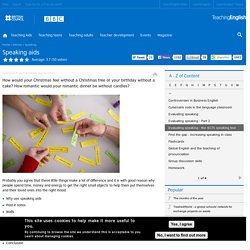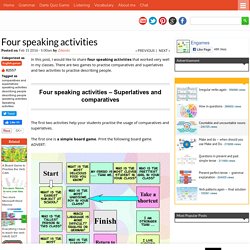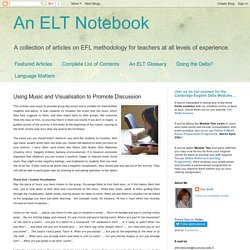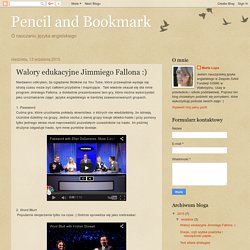

Speaking aids. Probably you agree that these little things make a lot of difference and it is with good reason why people spend time, money and energy to get the right small objects to help them put themselves and their loved ones into the right mood.

Why use speaking aids Post-it notes Walls Coloured paper Small objects To control turn-taking As metaphors Conclusion Why use speaking aids In contrast, we often expect that our students have the right mood to speak without having anything that would help them to be in the right mood to speak, or any prompt that would help the flow of ideas. These small prompts or small speaking aids get especially important when children get into the age when they want to speak about themselves more than e.g. about the little animals or fairies in a tale. Larry Ferlazzo - Using a "Three-Two-one" Speaking Activity. Using a "Three-Two-One" Speaking Activity English-language teacher trainer and author Paul Nation has developed the “4-3-2″ Fluency Activity.

In it, students line up (standing or sitting) facing each other. The best how-to videos on the web. Four speaking activities. In this post, I would like to share four speaking activities that worked very well in my classes.

There are two games to practise comparatives and superlatives and two activities to practise describing people. Four speaking activities – Superlatives and comparatives The first two activities help your students practise the usage of comparatives and superlatives. The first one is a simple board game. Print the following board game.
Using Music and Visualisation to Promote Discussion. This activity uses music to promote group discussion and is suitable for intermediate students and above.

It asks students to visualise the scene that the music which they hear suggests to them, and then report back to their groups. Not everyone finds this easy at first, so you may find it is more successful if you do it in stages - a guided version of the activity a few times at the beginning of the course, passing to the freer version only once they are used to the technique. The music you use should match whatever you want the students to visualise. New Age music usually works well, but what you choose will depend on what you have on your shelves. I have often used artists like Kitaro (Silk Road); Rick Wakeman (Country Airs); Vangelis (China); Santana (Caravanserai). Phase One : Guided VisualisationPlay the piece of music you have chosen to the group.
Listen to the music ... and as you listen I'd like you to visualise a scene... Five Picture Games. Pictures can be invaluable in the classroom for stimulating discussion.

Here are five ways they can be used. I’ve been using them all for the last thirty years, and they’re certainly not all original. But I honestly can’t remember where they came from. If anybody finds them elsewhere, please leave a comment with the source. 1. Take a picture into the classroom, but don’t show it to the students. Musical landscapes. Using Mr. Bean to Teach Present Continuous (Speaking Activity) English Current.
Skill focus: Speaking Grammar: Present Continuous (Present Progressive)

The Best Sites To Practice Speaking English. This was one of the trickiest “The Best…” list for me to compile.

As I was going through my favorites, and all of the great suggestions others contributed, I concluded that it might work best to really create two lists. The first list — this one — will highlight sites that actually have students recording their own voices in a number of different ways and post their speaking assignments online. The second list, which I’ll publish later this month and will include a number of the sites that readers suggested, will focus on sites where students have to listen to spoken examples for developing better pronunciation skills. Journal Jar - Free Journal Topic App for iPhone / iPod touch / iPad / Android.
Free online Dictionary of English Pronunciation - How to Pronounce English words. Conversation Questions for the ESL/EFL Classroom. Is it true? – Story telling game to practise narrative tenses. This is a quick game for intermediate level students and above.

I made it as a mingle for new students to get to know each other but over time it has shown that it’s a good exercise for practising the narrative tenses. To download the handout click here. Introduction The game starts with you telling your students a short story about yourself. The story can be true or made up. The game Each student is given a card like the one on the right. There are six different cards with a total of 18 different story titles. While students mingle, monitor for error correction at the end. Follow up. Mingling: Terry’s trip. Activity: information gapActivity type: mingling, asking and answering questions.Level: Up to B1.Age: Adults or Senior YLs PreparationWrite this on the board: He went to… He went by… The weather was… Elicit simple ideas about Harry’s holiday.

English Pronunciation – 4 Tips to Improve Your Accent. Walory edukacyjne Jimmiego Fallona :) Niedawno odkryłam, że oglądanie filmików na You Tube, które przeważnie wydaje się stratą czasu może być całkiem przydatne i inspirujące.

Taki właśnie okazał się dla mnie program Jimmiego Fallona, a dokładnie prezentowane tam gry, które można wykorzystać jako urozmaicenie zajęć języka angielskiego w bardziej zaawansowanych grupach. 1. Password Cudna gra, które uruchamia pokłady słownictwa, o których nie wiedzieliśmy, że istnieją. TeachingEnglish. Speaking aids. Presentations: Language expert. Phrases for Conversation. How to keep an English conversation going. Ways to avoid awkward silence. - learn English,communication,english. Motivating speaking activities for lower levels. Planning time has been shown to increase production in speaking tasks.
Lower level learners often find it especially difficult to speak spontaneously, so these activities incorporate 'thinking time' during which learners can prepare for speaking by planning what they are going to say, and asking the teacher or using a dictionary to look up missing vocabulary. The following activities are relatively short, with minimal materials preparation time for the teacher. They are designed for use as a warmer or a filler in the middle or at the end of a class. Circle games. They are mostly used with young learners, but teenagers will play them and so will the right kind of adult class: one that doesn't take itself too seriously.
What are circle games? Why and when? Managing circle games with young learnersActivities.